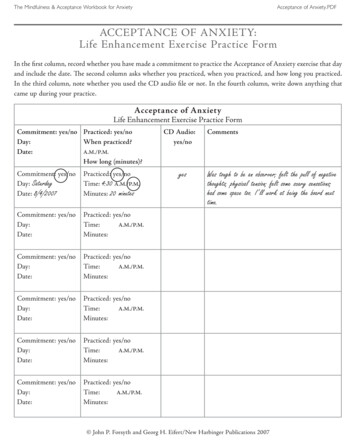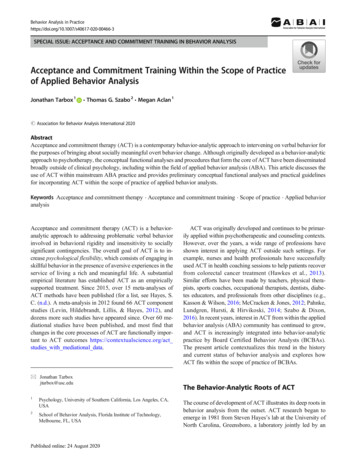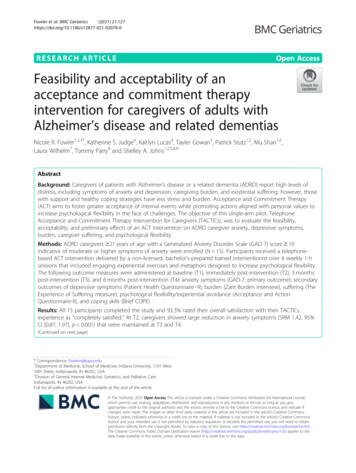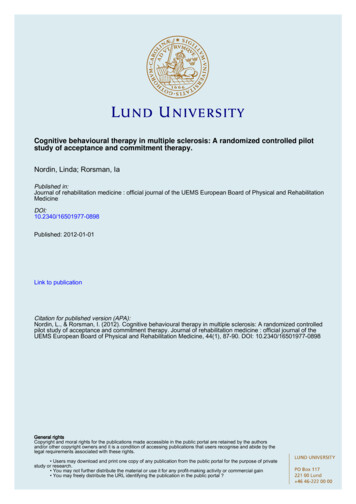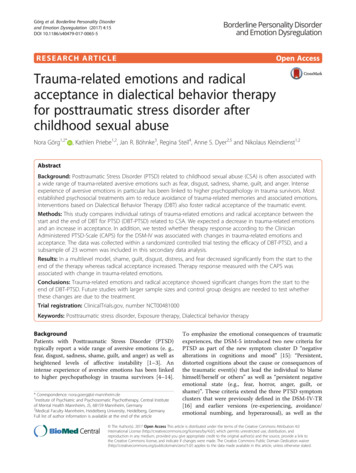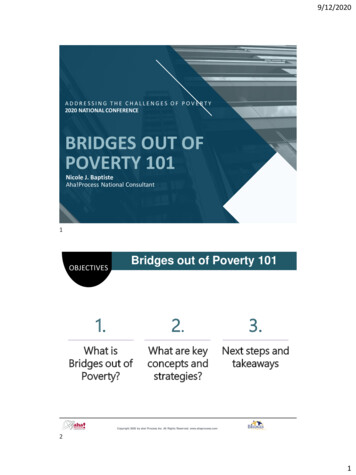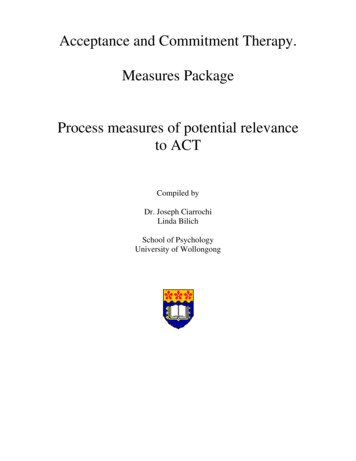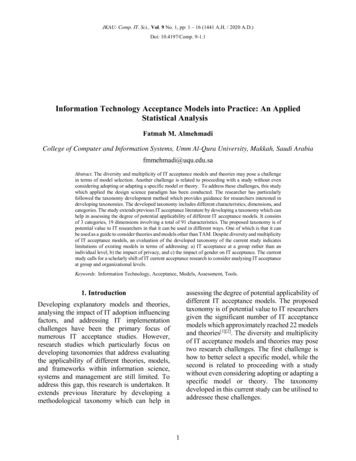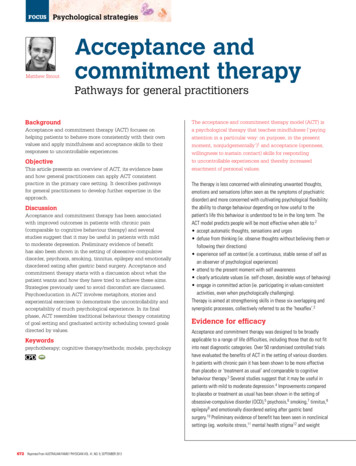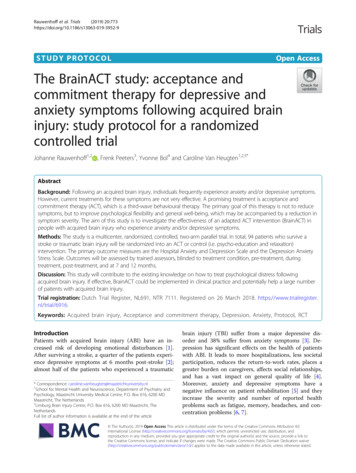
Transcription
Rauwenhoff et al. Trials(2019) DY PROTOCOLOpen AccessThe BrainACT study: acceptance andcommitment therapy for depressive andanxiety symptoms following acquired braininjury: study protocol for a randomizedcontrolled trialJohanne Rauwenhoff1,2 , Frenk Peeters3, Yvonne Bol4 and Caroline Van Heugten1,2,5*AbstractBackground: Following an acquired brain injury, individuals frequently experience anxiety and/or depressive symptoms.However, current treatments for these symptoms are not very effective. A promising treatment is acceptance andcommitment therapy (ACT), which is a third-wave behavioural therapy. The primary goal of this therapy is not to reducesymptoms, but to improve psychological flexibility and general well-being, which may be accompanied by a reduction insymptom severity. The aim of this study is to investigate the effectiveness of an adapted ACT intervention (BrainACT) inpeople with acquired brain injury who experience anxiety and/or depressive symptoms.Methods: The study is a multicenter, randomized, controlled, two-arm parallel trial. In total, 94 patients who survive astroke or traumatic brain injury will be randomized into an ACT or control (i.e. psycho-education and relaxation)intervention. The primary outcome measures are the Hospital Anxiety and Depression Scale and the Depression AnxietyStress Scale. Outcomes will be assessed by trained assessors, blinded to treatment condition, pre-treatment, duringtreatment, post-treatment, and at 7 and 12 months.Discussion: This study will contribute to the existing knowledge on how to treat psychological distress followingacquired brain injury. If effective, BrainACT could be implemented in clinical practice and potentially help a large numberof patients with acquired brain injury.Trial registration: Dutch Trial Register, NL691, NTR 7111. Registered on 26 March 2018. https://www.trialregister.nl/trial/6916.Keywords: Acquired brain injury, Acceptance and commitment therapy, Depression, Anxiety, Protocol, RCTIntroductionPatients with acquired brain injury (ABI) have an increased risk of developing emotional disturbances [1].After surviving a stroke, a quarter of the patients experience depressive symptoms at 6 months post-stroke [2];almost half of the patients who experienced a traumatic* Correspondence: caroline.vanheugten@maastrichtuniversity.nl1School for Mental Health and Neuroscience, Department of Psychiatry andPsychology, Maastricht University Medical Centre, P.O. Box 616, 6200 MDMaastricht, The Netherlands2Limburg Brain Injury Centre, P.O. Box 616, 6200 MD Maastricht, TheNetherlandsFull list of author information is available at the end of the articlebrain injury (TBI) suffer from a major depressive disorder and 38% suffer from anxiety symptoms [3]. Depression has significant effects on the health of patientswith ABI. It leads to more hospitalizations, less societalparticipation, reduces the return-to-work rates, places agreater burden on caregivers, affects social relationships,and has a vast impact on general quality of life [4].Moreover, anxiety and depressive symptoms have anegative influence on patient rehabilitation [5] and theyincrease the severity and number of reported healthproblems such as fatigue, memory, headaches, and concentration problems [6, 7]. The Author(s). 2019 Open Access This article is distributed under the terms of the Creative Commons Attribution 4.0International License (http://creativecommons.org/licenses/by/4.0/), which permits unrestricted use, distribution, andreproduction in any medium, provided you give appropriate credit to the original author(s) and the source, provide a link tothe Creative Commons license, and indicate if changes were made. The Creative Commons Public Domain Dedication o/1.0/) applies to the data made available in this article, unless otherwise stated.
Rauwenhoff et al. Trials(2019) 20:773Despite their high prevalence and negative consequences with a significant burden of disease, it is stillnot clear how to best treat post-ABI symptoms of depression and anxiety. Psychopharmacological interventions have mixed results when treating depression instroke survivors. Additionally, stroke patients seem sensitive to the side effects of psychopharmacological medication [8]. Furthermore, antidepressants have not beenshown to be more beneficial than placebo when treatingdepression following TBI [9]. Cognitive behaviouraltherapy is widely used for treating depression and anxiety, but there is no strong evidence for its post-strokeeffectiveness [10, 11], and research into its effectivenessfollowing TBI is inconclusive [12–15].A recent type of therapy that has been proven to be effective over a wide range of clinical populations is acceptance and commitment therapy (ACT) [16–19]. ACTis a third-wave cognitive behavioural therapy, which usescommitment and behaviour change strategies to increasepsychological flexibility [20]. Psychological flexibility isdescribed as “the ability to contact the present momentmore fully as a conscious human being, and to changeor persist in behaviour when doing so serves valuedends” [21], p., 7. This results from a combination of thesix core processes of ACT: acceptance (accepting positive and negative thoughts to situations one cannotchange), defusion (disentanglement of thoughts), senseof self (separating the self from the process of thinking),mindfulness (contact with the present moment), valuedliving (being aware of what really matters), and committed action (taking action guided by one’s values) [21].Although symptom reduction is not the primary treatment goal, an increase in psychological flexibility is oftenaccompanied by a decrease in symptomatology [22, 23].ACT is an interesting approach for people with ABI whosuffer from psychological distress [24]. Instead of applying cognitive restructuring techniques as used in traditional cognitive therapy, ACT focusses on learning toaccept both the negative and positive thoughts and feelings related to those circumstances that cannot be changed or controlled [25]. It enables the individual to carryout value-based behaviour while feeling distressed [25].Higher levels of acceptance and valued living have beenassociated with better psychological outcomes in patients with ABI [26–28].Currently, there is some evidence that people who developed depressive or anxiety symptoms after ABI canbenefit from ACT. Majumdar and Morris [29] performed a randomized controlled trial (RCT) in which anACT group-intervention of four weekly didactic PowerPoint sessions was compared to treatment as usual instroke survivors. They found that people in the ACTintervention showed a significant reduction in depression and increased hopefulness and self-rated health.Page 2 of 10However, there were no differences identified in relationto anxiety or quality of life. Graham, Gillanders, Stuart,and Gouick [30] described a case study in which a strokepatient no longer experienced chest pain, had a decreasein anxiety and depressive symptoms, and improved illness perception and psychological flexibility following anACT intervention. Whiting, Deane, McLeod, Ciarrochiand Simpson [31] performed a pilot RCT comparing anACT group intervention with befriending therapy in patients with severe TBI. Their results show that ACT decreased the levels of anxiety and depression significantlycompared to the befriending treatment. However, itcould not be confirmed that the mechanism throughwhich this decrease was elicited was psychological flexibility [31]. These findings should, however, be considered in light of the small sample size of the study andthe restricted sample characteristics.These studies provide preliminary support for thehypothesis that ACT can be effective in treating psychological distress following ABI. With the current BrainACT study, we aim to investigate whether an ACTintervention, adapted for the needs and possible cognitive deficits of people with ABI, results in decreased anxiety and depressive symptoms compared to a controlintervention. Furthermore, we will examine ACT-relatedprocesses, quality of life, social participation, and thecost-effectiveness of both interventions.Research questions addressed in the study are:1. Does ACT lead to a greater reduction of depressiveand anxiety symptoms in patients with ABIcompared to an active control intervention (i.e.psycho-education and relaxation training)?2. Is ACT more cost-effective in comparison to anactive control intervention?3. Is the (potential) reduction of anxiety anddepressive symptoms mediated by an increase inpsychological flexibility, acceptance, valued living,and/or cognitive defusion in the ACT group?4. Does ACT lead to higher levels of participation andquality of life, compared to an active controlcondition?MethodsStudy designThe design of the study is a multicenter, randomized,controlled, two-arm parallel trial in which an 8-weekACT intervention will be compared to an active controlintervention, namely psycho-education combined withrelaxation training. Outcome measures will be collectedat baseline (T0), after 1 month (T1; during treatment),and after 3 months (T2; post-treatment). There will befollow-up measurements at 7 months (T3) and 12months (T4). See Fig. 1 for the flow chart of the study.
Rauwenhoff et al. Trials(2019) 20:773Page 3 of 10Fig. 1 Design of the study: multicenter, randomized, controlled, two-arm parallel trialEthics approval for the study has been given by the medical research ethics committee of Maastricht UniversityMedical Centre and Maastricht University and the localcommittees of participating clinical centres. The study isregistered in the Dutch Trial Register (TC: 7111).ParticipantsA total of 94 survivors of TBI or stroke will be recruitedfrom rehabilitation or medical psychology departmentsat hospitals in the Netherlands. Patients who have beenreferred to a psychologist will be considered for participation. Possible participants will be screened and informed about the study by their psychologists foreligibility. Inclusion criteria are (1) having sustained anytype of stroke or TBI, which is objectified by a neurologist; (2) scoring 7 on the depression and/or anxietysubscale of the Hospital Anxiety and Depression Scale(HADS); (3) being 18 years or older; (4) having a stableuse of psychotropic medication (such as antidepressants)for the duration of the study and stable use of antidepressants during 4 weeks prior to the start of the study;(5) being able to access the Internet and a computer because treatment materials such as patient videos areshown via the Internet; (6) mastering the Dutch language sufficiently to benefit from treatment; and (7) giving informed consent. Exclusion criteria are (1) historyof brain injury or any neurological disorder other than astroke and TBI; (2) pre-morbid disability as assessed bythe Barthel Index (score 19/20); (3) severe comorbidity, for which treatment is given at the momentof inclusion, that might affect the outcome; (4) presenceof a DSM 5-based mood and/or anxiety disorder forwhich pharmacological and/or psychological treatmentwas necessary during the onset of the brain injury; and(5) attendance in a previous ACT intervention for comparable problems in the year proceeding entry to thecurrent study.Randomization and blindingParticipants who are eligible and agree to participate inthe study are randomly assigned to either the intervention group or the control group with an allocation ratioof 1:1. An independent third person will randomizeparticipants centrally using computerized blockrandomization. The block size is six and therandomization scheme includes pre-stratification on typeof brain injury (TBI versus stroke). The randomizationscheme has been developed with the use of a randomgenerator (www.random.org). After randomization, anopaque, sealed envelope will be prepared containing information about the group allocation of the participantby the independent third person. After the first
Rauwenhoff et al. Trials(2019) 20:773measurement time point (T0) the researcher will openthe sealed envelope and reveal the treatment allocationto the patient and psychologist.The trained research assistants that administer thequestionnaires will be blinded to treatment allocation(i.e. intervention or control) and should never be unblinded. Participants will be asked not to tell researchassistants about the treatment they received. In order tocheck the success of blinding, at T4 the research assistants will be asked to indicate group allocation for allparticipants who completed the trial. The researchassistants will choose one of the following options:“Intervention group”, “Control group”, or “I don’t know”.Participants will not be blinded to treatment allocation.Data will be analysed by the principal investigator (JR)who will be blinded to treatment allocation while performing the analyses.Primary outcome measuresPsychological distressThe subscales of the HADS will be used to measure anxiety and depressive symptoms over the past 7 days. Thescores for the scales, seven items each, range from 0 to21 with higher scores indicating higher levels of depression or anxiety. This questionnaire has been validated ina sample of patients with TBI [32]. Furthermore, therewas good internal consistency for both subscales (Cronbach α depression scale, 0.81; anxiety scale, 0.84) in patients with stroke [33]. The Depression Anxiety StressScales-21 (DASS-21) will be used to measure the participants’ levels of anxiety, depression, and stress. It consistsof 21 items, which are rated on a 4-point Likert scale.The score ranges from 0 to 63 with higher scores indicating greater levels of depression, anxiety, or stress. Thequestionnaire has been validated in a sample of patientswith TBI. The internal consistency was good for thethree scales (Cronbach α depression scale, 0.90; stressscale, 0.89; anxiety scale. 0.82) [34]. The primary outcome is the difference between groups in change inmood and anxiety symptoms over all time points, asmeasured by the total scores of the respective subscalesof the HADS and DASS-21.Cost effectivenessTwo questionnaires will be used to measure cost effectiveness: the 5-level Euroqol-5 dimensions (EQ-5D-5 L)and a 16-item cost questionnaire. The EQ-5D-5 L consists of five questions measuring health status. The dimensions covered are mobility, self-care, daily activities(such as work, housework, study, and leisure activities),pain or discomfort, and anxiety or depression. Thesedomains are rated as “no problem”, “slight problem”,“‘moderate problem”, “severe problem”, or “unable todo”. Consequently, the EQ-5D-5 L can distinguishPage 4 of 10between different health states. For each of the differentstates a weight is contributed based on the valuationgiven by the general population [35]. The healthcarecosts of participants will be measured with a self-reportcost questionnaire, which is constructed to collect costdata from a societal perspective, based on the steps described by Thorn et al. [36]. The cost questionnaire usedin this study is based on a questionnaire used in thestudy of Kootker et al. [11]. Several questions are alteredbased on response patterns and analyses in this priorstudy. The primary cost-effectiveness outcome is thechange in the amount of care used between groups overall time points, as measured by the total scores of thecost-questionnaire and the EQ-5D-5 L.Secondary outcome measuresParticipationThe Utrecht Scale for Evaluation of RehabilitationParticipation (USER-P) will be used to measure threeaspects of participation: frequency of behaviours, participation restrictions experienced due to health condition,and satisfaction with participation. The frequency scalemeasures the objective level of participation, while therestrictions and satisfaction scales offer an insight intothe subjective rating of participation. The questionnaire consists of 31 items. A score ranging from 0 to100 is calculated for each scale. Higher scores indicate more participation, less restriction, and more satisfaction. It is a valid and reliable measure forpatients with ABI; the internal consistency is good(Cronbach α 0.70–0.91) [37].Health statusThe Short Form Survey (SF-12) will be used to measurethe health status of the participants. The total scoreranges from 0 to 100 and a higher score indicates betterhealth status. The SF-12 has been validated for use inTBI research [38]. The secondary outcome is the difference between groups in change in participation andhealth status over all time points, as measured by thetotal scores of the respective subscales of the USER-Pand SF-12.Secondary process measuresPsychological flexibilityThe Acceptance and Action Questionnaire II (AAQ-II)is a seven-item questionnaire measuring psychologicalflexibility. The items are scored on a 7-point Likert scaleand the total score ranges from 0 to 49 with a higherscore indicating more psychological flexibility. The internal consistency of the AAQ-II is good (Cronbach α 0.84) [39]. Furthermore, the questionnaire has beenvalidated in a sample of patients with ABI [40]. The Acceptance and Action Questionnaire after brain injury
Rauwenhoff et al. Trials(2019) 20:773(AAQ-ABI) measures psychological flexibility about thethoughts and feelings related to the brain injury, whilethe AAQ-II measures psychological flexibility aroundgeneral psychological distress. The AAQ-ABI consists ofseven items, which are scored on a 5-point Likert scale.The score ranges from 0 to 36 with higher scores indicating greater psychological flexibility. The questionnairehas good internal consistency (Cronbach α 0.89) [40].Valued livingThe Valued Living Questionnaire (VLQ) is a two-partinstrument that measures valued living. First, theparticipant rates the importance of ten value domainson a 10-point Likert scale. Second, participants rate howconsistently he or she has lived in accordance with theirvalues within these domains. Scores from both parts areused to calculate a valued living component. The internal consistency of the valued living component hasbeen demonstrated as adequate (Cronbach α 0.74)[41]. The VLQ has been used in earlier research tomeasure valued living in patients with TBI [27].Cognitive fusionThe Cognitive Fusion Questionnaire (CFQ-7) measurescognitive fusion on a 7-point Likert scale. Scores rangefrom 0 to 49. The higher the score, the more fused oneis with one’s thoughts. Earlier research has shown thatthe CFQ has good factor structure, validity, reliability,and stability over time [42]. The questionnaire has beenvalidated in healthy individuals and in patients [42, 43].The secondary process outcome is the difference between groups in change in psychological flexibility, valued living, and cognitive fusion over all time points, asmeasured by the total scores of the respective subscalesof the AAQ-II, AAQ-ABI, VLQ, and CFQ-7.Personal and brain-injury-related characteristics andfeasibilityParticipants will fill out a demographic questionnaire atthe start of the study. This questionnaire will registerage, gender, employment, and education. Injury-relatedfactors will be obtained from the medical files of the participants. These include type of brain injury, time sincebrain injury, severity of injury, and affected hemisphereof the brain. After ending the treatment, the participant’sopinion of and satisfaction with the ACT (treatmentfeasibility) will be questioned by means of a short semistructured interview.ProcedureParticipants will be recruited at participating hospitalsand rehabilitation centers in the Netherlands. To preventunnecessary burden, the psychologists will check the inclusion and exclusion criteria. If the patient is willing toPage 5 of 10participate the investigator will meet with the patient (atthe patient’s home, the hospital, or the university, as preferred by the patient) to discuss the participation in thestudy and answer questions. If all is clear the informedconsent form will be signed by the patient and the researcher (see Additional file 2). Subsequently, the firstmeasurements will take place (T0) and the participantwill be randomly allocated to the experimental group receiving ACT or to the active control group receivingpsycho-education. The therapy sessions will be scheduled with the psychologist or healthcare professional.One month after the start of the intervention bothgroups will fill in the questionnaires for T1 (see Fig. 2).Questionnaires will be filled in on paper and measurements will be conducted by a research assistant blindedto allocation. After 3 months, when the treatment program is completed, the participants will fill in the questionnaires for T2. There will be follow-up measurementsat 7 months (T3) and 12 months (T4). Again, these measurements will be conducted by a research assistantblinded to allocation. Research assistants will enter thedata and data entry will be periodically checked duringthe monitoring visits. Follow-up appointments will beplanned at the end of each visit. The research assistantwill remind participants of their appointment by telephone or e-mail 1 week before the appointment is due.During the assessments, the researcher and research assistants will be alert for any adverse events such as suicidality. All adverse events related to mood complaintsreported spontaneously by the subject or observed willbe systematically collected and reported to the medicalresearch ethics committee. Based upon these events thedecision may be made to discontinue participation inthe study. Furthermore, participants can leave the studywithout any consequences, at any time, for any reason ifthey wish to do so. The investigator can decide to withdraw a subject from the study for urgent medicalreasons.InterventionsBrainACT interventionThe ACT intervention involves eight weekly individualsessions of 60 min during a period of 3.5 months. Thefirst four sessions are weekly, thereafter the sessions willbe biweekly, with a 3-week break between the seventhsession and last session. Participants will do homeworkexercises of around 30 min for 6 days a week. Homework consists of reading or listening to summaries ofthe sessions, practising skills, and doing mindfulness exercises. At the start of the intervention, participants willreceive a workbook with instructions that they can readat home after each session. We use an eight-sessionprotocol (see Table 1) based on Jansen and Batink [44],Luoma, Hayes, and Walser [45], and Whiting et al. [31]
Rauwenhoff et al. Trials(2019) 20:773Page 6 of 10Fig. 2 Standard protocol items: recommendation for interventional trials (SPIRIT) diagramTable 1 Overview of the BrainACT treatment programmeTopicContentValuesValue exploration and difference betweengoals and actionsCommitted action andMindfulnessCommitted action on the long and short termin relation to values, education aboutmindfulness, and practising contact with thepresent momentEffect of controlCreative hopelessness; the undeniability ofhuman suffering and the long-term consequences of trying to control itAcceptanceIntroducing acceptance as an alternative tocontrolDefusionChanging the relationship with thoughts,naming the mindSelf-as-contextChanging the relationship with thoughts aboutoneself and introducing the constant selfDefusion andMindfulnessReview and exercises on defusion andmindfulnessPsychological flexibilityReview of the different core components,explanation on how these skills together leadto psychological flexibility, and preparation onrelapse and setbacksin which all six ACT core processes are addressed. Psychologists are free to decide on the order of the sessions.We altered the treatment for people with ABI as suggested by Kangas and McDonald [24] and Broomfieldet al. [46]. An expert group of psychologists experiencedin ACT and/or in working with people with ABI gavefurther advice on the alterations. The possible cognitivedeficits of the participants are taken into account andbrain-injury-related topics are discussed during thetreatment. A treatment protocol is specified to ensurecomparability of the ACT intervention across settings.The intervention will be provided individually by certified psychologists who completed an ACT trainingcourse of at least 5 days and are experienced in workingwith patients with ABI. The therapy will take place athospital outpatient facilities.Active control interventionThe control condition (see Table 2 for an overview) consists of an eight-session psycho-education interventioncombined with relaxation training with a duration of 1h. A Cochrane review concluded that active informationprovision is able to reduce depression and anxiety afterbrain injury [47]. Furthermore, earlier research hasshown that relaxation exercises reduce post-stroke
Rauwenhoff et al. Trials(2019) 20:773Table 2 Overview of the psycho-education and relaxationtreatment programSessionnumberContent1Psycho-education on the basic functions of the brain andcauses of brain injury2Psycho-education on relaxation training and aprogressive muscle relaxation exercise3Psycho-education on the consequences of brain injuryand a progressive muscle relaxation exercise4Psycho-education on changes in behaviour and moodfollowing brain injury and an autogenic training exercise5Psycho-education on fatigue following brain injury andan autogenic training exercise6Psycho-education on memory problems following braininjury. Participants can choose between autogenictraining or a progressive muscle relaxation exercise. Thistechnique will also be used in the following sessions7Psycho-education on information processing andplanning and an autogenic training exercise or aprogressive muscle relaxation exercise8Review of the different sessions, wrap up, and anautogenic training exercise or a progressive musclerelaxation exerciseanxiety [48]. The psycho-education is based on the existing module Niet rennen maar plannen (don’t run, plan)[49], which is a training and education programme focussing on cognitive rehabilitation for patients withbrain damage and mild cognitive problems. The intervention aims to offer information and education aboutbrain injury and its consequences. Relaxation exercisesconsist of progressive muscle relaxation [50] and autogenic training [51]. Participants will do homework exercises of around 30 min for 6 days a week. A treatmentprotocol is specified to ensure comparability of the education intervention across settings. This intervention willbe provided individually by a healthcare professionalwith experience in working with patients with brain injury (e.g. psychologist, social worker, occupational therapist, psychological assistant, but not the psychologistproviding the ACT intervention) at hospital outpatientfacilities.Page 7 of 10Sample size calculationThe sample size calculation was performed usingG*Power based on a repeated measures design. With alarge effect size of 0.4, alpha value of 0.05, power valueof 0.80, two groups (intervention and control), and fivemeasurements, at least 80 participants are required.With an expected drop-out rate of 15%, 94 participantsneed to be recruited.Statistical analysisThe statistical analysis can be divided into four parts.First, the baseline characteristics will be described. Second, between-group differences at baseline will be analysed using the chi-square test and independent samplest test to verify the success of randomization. Furthermore, groups will be compared on primary outcomemeasures at T2 using the chi-square test and independent sample t test. Linear mixed models for repeatedmeasures will be used to study the differences betweengroups with the primary and secondary outcome measures as dependent variables. Models will include maineffects of the intervention (ACT or psycho-education)and time (T0, T1, T2, T3, and T4) as categorical variables and the interaction effect of intervention and time.Baseline-adjusted mean differences between groups ateach time point with 95% confidence intervals will becalculated. The effects of the intervention will be analysed according to the intention-to-treat principle. Alphawill be set at 0.05. All quantitative analyses will be conducted using SPSS software version 25 [52]. Clinicallysignificant change will be determined on the primaryoutcome measures [53] to gain insight into clinical improvement on an individual level. The first step is toidentify patients who “recovered” by using the cut-offscores of the primary outcome measures (HADS andDASS-21). The second step is to calculate the reliablechange index, which identifies the patients with a significant improvement. Patients who both recovered andshowed a significant improvement will be consideredclinically significantly improved. The number ofclinically significantly improved patients will be compared between interventions. The trial-based economicevaluation will involve a combination of costeffectiveness analysis and cost-utility analysis.AdherenceEthical considerations and disseminationTo ensure adherence to the intervention protocol, alltherapists (for the intervention and control condition)will be trained by the principal investigator (JR). Furthermore, to examine the adherence during the different sessions, therapists have to fill in a checklist after everysession. They tick off which exercises were done according to the treatment protocol and which exercises wereadded or left out.Data will be handled confidentially and reporting will becoded. Each participant is given a personal code, whichcan only be linked to a person when the coding key isknown. Collected data and personal information will bestored separately. The coded dataset will be available tothe research team, healthcare inspectorate, study monitors, and members of the medical research ethics committee. The handling of personal data will comply with
Rauwe
A recent type of therapy that has been proven to be ef-fective over a wide range of clinical populations is ac-ceptance and commitment therapy (ACT) [16-19]. ACT is a third-wave cognitive behavioural therapy, which uses commitment and behaviour change strategies to increase psychological flexibility [20]. Psychological flexibility is


